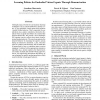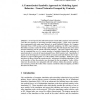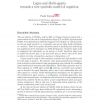112 search results - page 7 / 23 » Power and the limits of reactive agents |
HICSS
1998
IEEE
13 years 11 months ago
1998
IEEE
In recent years, electric utility industry in the whole world has been facing pressure to be deregulated or restructured in order to increase its efficiency, to reduce operational...
IJCAI
2007
13 years 8 months ago
2007
Although many powerful AI and machine learning techniques exist, it remains difficult to quickly create AI for embodied virtual agents that produces visually lifelike behavior. T...
EWSN
2006
Springer
14 years 6 months ago
2006
Springer
Time synchronization is a crucial component of a large class of sensor network applications, traditionally implemented as a standalone middleware service that provides a virtual gl...
CONTEXT
2001
Springer
13 years 11 months ago
2001
Springer
A recent report by the National Research Council (NRC) declares neural networks “hold the most promise for providing powerful learning models”. While some researchers have expe...
ENTCS
2002
13 years 6 months ago
2002
Abstract The last edition of CLIMA, held in 2001 in Paphos (Cyprus) ended with a panel session on the role of Computational Logic (CL) in Multi-Agent Systems (MAS). Two dimensions ...



